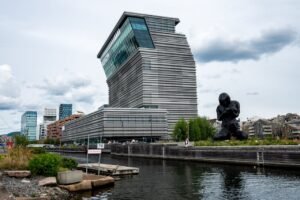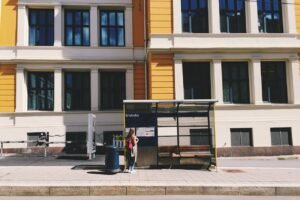

Colors of Norway: A Comprehensive List of Norwegian Color Adjectives
Color adjectives play a significant role in language, allowing us to describe and communicate the visual world around us. In the Norwegian language, color adjectives are no exception. Norwegian, a North Germanic language spoken primarily in Norway, has a rich vocabulary when it comes to colors. Understanding and using these color adjectives can enhance one’s ability to express themselves and engage with Norwegian culture.
Table of Contents
ToggleKey Takeaways
- Norwegian color adjectives play an important role in describing objects, emotions, and nature.
- Colors hold significant cultural and historical meanings in Norwegian society.
- Warm colors in Norwegian vocabulary include rød (red), oransje (orange), and gul (yellow).
- Cool colors in Norwegian vocabulary include blå (blue), grønn (green), and lilla (purple).
- Earthy colors in Norwegian vocabulary include brun (brown), grå (gray), and beige (beige).
- Vibrant colors in Norwegian vocabulary include rosa (pink), turkis (turquoise), and fiolett (violet).
- Pastel colors in Norwegian vocabulary include pastellblå (pastel blue), pastellgrønn (pastel green), and pastellrosa (pastel pink).
- Dark colors in Norwegian vocabulary include svart (black), mørk blå (dark blue), and mørk grønn (dark green).
- Light colors in Norwegian vocabulary include lys blå (light blue), lys grønn (light green), and lys rosa (light pink).
- Rare and unique color adjectives in Norwegian vocabulary include koboltblå (cobalt blue), kremhvit (cream white), and sjokoladebrun (chocolate brown).
The Significance of Colors in Norwegian Culture
Colors hold great cultural significance in Norway. They are often associated with various traditions, celebrations, and even national identity. For example, red is a color that is deeply rooted in Norwegian culture. It is associated with the country’s flag and is often used to symbolize love, passion, and warmth. On the other hand, blue is another important color in Norwegian culture, representing tranquility, loyalty, and the country’s connection to the sea.
Norwegians also have a strong connection to nature, and this is reflected in their use of colors. Green, for instance, represents the lush landscapes and forests that cover much of the country. It symbolizes growth, fertility, and harmony with nature. Similarly, white is often associated with snow and ice, which are prominent features of the Norwegian landscape. It represents purity, innocence, and the beauty of winter.
Warm Colors in Norwegian Vocabulary
Norwegian has a variety of warm color adjectives that are used to describe colors on the warm end of the spectrum. Some examples include “rød” (red), “gul” (yellow), “oransje” (orange), and “brun” (brown). These warm colors are often associated with feelings of energy, warmth, and vibrancy.
In everyday language, warm colors are used to describe objects or scenes that evoke a sense of warmth or passion. For example, one might describe a beautiful sunset as “rød” (red) or “oransje” (orange). Warm colors are also commonly used in Norwegian traditions and celebrations. For instance, during Christmas, the color red is prominently featured in decorations and clothing, symbolizing warmth, love, and the holiday spirit.
Cool Colors in Norwegian Vocabulary
| Cool Colors in Norwegian Vocabulary | Translation |
|---|---|
| Blå | Blue |
| Grønn | Green |
| Lilla | Purple |
| Turkis | Turquoise |
| Indigo | Indigo |
| Sjøgrønn | Sea green |
| Teal | Teal |
Cool colors are also well-represented in the Norwegian language. Some examples of cool color adjectives in Norwegian include “blå” (blue), “grønn” (green), “lilla” (purple), and “turkis” (turquoise). These colors are often associated with feelings of calmness, tranquility, and serenity.
In everyday language, cool colors are used to describe objects or scenes that evoke a sense of coolness or peacefulness. For example, one might describe a serene lake as “blå” (blue) or a peaceful forest as “grønn” (green). Cool colors are also used in Norwegian culture to represent certain emotions or concepts. For instance, blue is often associated with loyalty and trust, while green represents harmony with nature.
Earthy Colors in Norwegian Vocabulary
Earthy colors are an important part of the Norwegian color vocabulary. These colors are often associated with nature and the earth. Some examples of earthy color adjectives in Norwegian include “grå” (gray), “brun” (brown), “beige” (beige), and “gulbrun” (yellow-brown).
In everyday language, earthy colors are used to describe objects or scenes that have a natural or organic feel. For example, one might describe a rocky mountain as “grå” (gray) or a sandy beach as “brun” (brown). Earthy colors are also commonly used in Norwegian culture to represent simplicity, authenticity, and a connection to the natural world.
Vibrant Colors in Norwegian Vocabulary

Vibrant colors are full of energy and intensity, and they are well-represented in the Norwegian language. Some examples of vibrant color adjectives in Norwegian include “sterk” (strong), “intens” (intense), “lys” (bright), and “skrikende” (screaming).
In everyday language, vibrant colors are used to describe objects or scenes that are bold, eye-catching, or full of life. For example, one might describe a vibrant sunset as “lys” (bright) or a colorful painting as “skrikende” (screaming). Vibrant colors are also commonly used in Norwegian culture to represent excitement, passion, and creativity.
Pastel Colors in Norwegian Vocabulary
Pastel colors are soft, delicate, and often associated with a sense of calmness and tranquility. In the Norwegian language, there are several pastel color adjectives that can be used to describe these gentle hues. Some examples include “pastellrosa” (pastel pink), “pastellblå” (pastel blue), “pastellgrønn” (pastel green), and “pastellgul” (pastel yellow).
In everyday language, pastel colors are used to describe objects or scenes that have a soft and soothing appearance. For example, one might describe a pastel-colored sunset as “pastellrosa” (pastel pink) or a pastel-colored flower as “pastellgul” (pastel yellow). Pastel colors are also commonly used in Norwegian culture to represent femininity, innocence, and a sense of tranquility.
Dark Colors in Norwegian Vocabulary
Dark colors can evoke a sense of mystery, elegance, and sophistication. In the Norwegian language, there are several dark color adjectives that can be used to describe these rich hues. Some examples include “mørk” (dark), “svart” (black), “gråsvart” (gray-black), and “mørkeblå” (dark blue).
In everyday language, dark colors are used to describe objects or scenes that have a deep and intense appearance. For example, one might describe a dark night sky as “mørk” (dark) or a black dress as “svart” (black). Dark colors are also commonly used in Norwegian culture to represent elegance, power, and a sense of mystery.
Light Colors in Norwegian Vocabulary
Light colors are often associated with purity, innocence, and a sense of openness. In the Norwegian language, there are several light color adjectives that can be used to describe these gentle hues. Some examples include “lys” (light), “hvit” (white), “lysblå” (light blue), and “lysrosa” (light pink).
In everyday language, light colors are used to describe objects or scenes that have a soft and gentle appearance. For example, one might describe a light-filled room as “lys” (light) or a white flower as “hvit” (white). Light colors are also commonly used in Norwegian culture to represent purity, innocence, and a sense of openness.
Rare and Unique Color Adjectives in Norwegian Vocabulary
In addition to the more common color adjectives, the Norwegian language also has some rare and unique color adjectives that can be used to describe specific shades or tones. Some examples include “kobberfarget” (copper-colored), “safirblå” (sapphire blue), “korallrød” (coral red), and “lavendellilla” (lavender purple).
These rare and unique color adjectives allow for more precise and nuanced descriptions of colors. They can be used to describe specific shades or tones that may not be easily captured by more general color adjectives. These adjectives add depth and richness to the Norwegian color vocabulary, allowing for a more vibrant and expressive language.
Color adjectives play a significant role in the Norwegian language and culture. They allow for the expression of emotions, descriptions of the visual world, and the communication of cultural symbols and traditions. Understanding and using Norwegian color vocabulary can enhance one’s ability to engage with the language and culture, as well as deepen their understanding of Norwegian traditions and celebrations. So, whether you’re learning Norwegian or simply interested in exploring the language’s rich color vocabulary, take the time to delve into the world of Norwegian colors and discover the beauty and significance they hold.

Norwegian A1-A2
Course Overview The Norwegian A1-A2 course is an online program focused on teaching essential Norwegian grammar and vocabulary. It includes a variety of materials and topics, with opportunities to interact with a Norwegian teacher entirely online. Curriculum Highlights The course covers key areas such as grammar and vocabulary and topics such as family, daily life, education, work, traditions, and leisure activities. Who Should Enroll? This course is perfect for beginners or those at the A1 or A2 levels who want to improve their Norwegian skills. What You Get Access to the full Norwegian A1-A2 course. A monthly 1-hour online conversation with a teacher. Many written and oral assignments. Comprehensive information on Norwegian grammar, Norwegian vocabulary and how to use them, important sentence structures, etc. Tips on additional resources to further enhance your Norwegian learning.
0 students enrolled
Last updated Dec 10th, 2024
If you want to learn Norwegian, you can register for classes here. We look forward to hearing from you and helping you become fluent in Norwegian.





